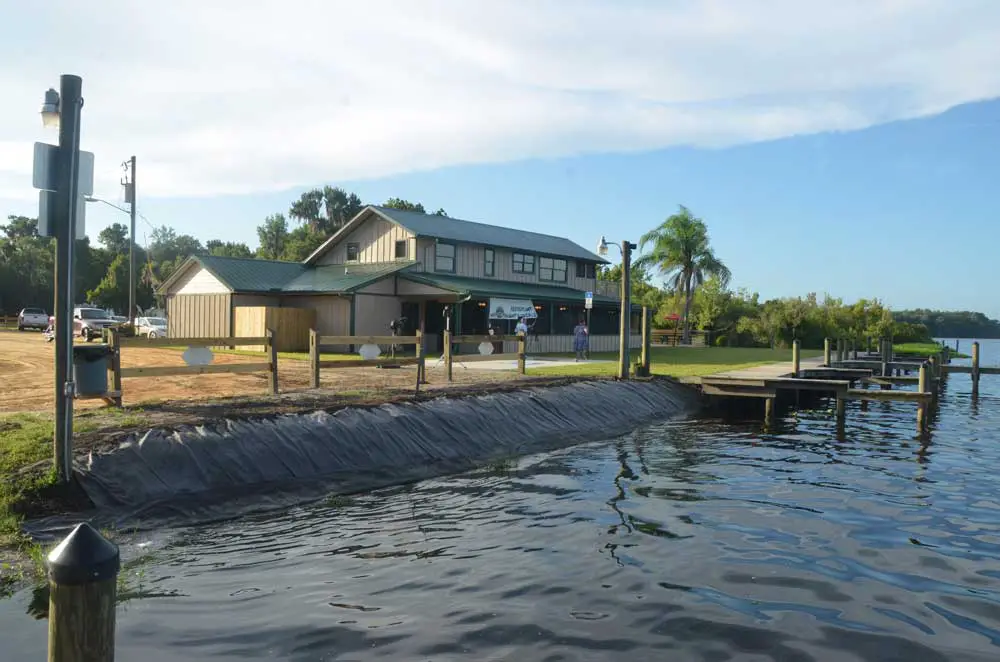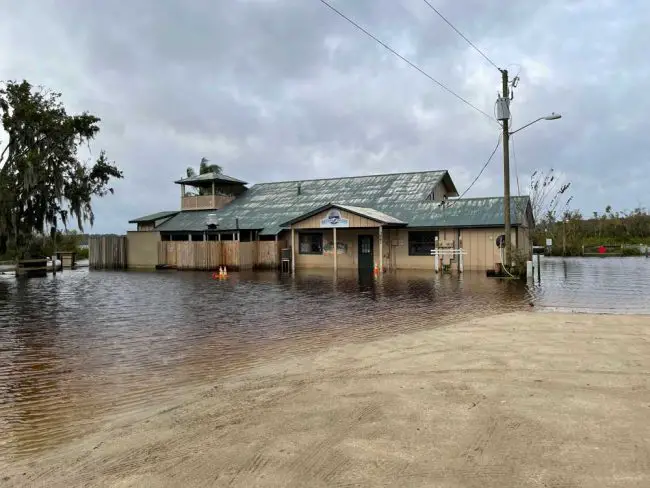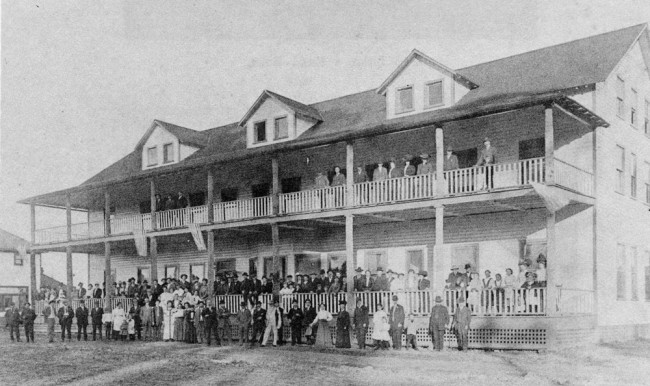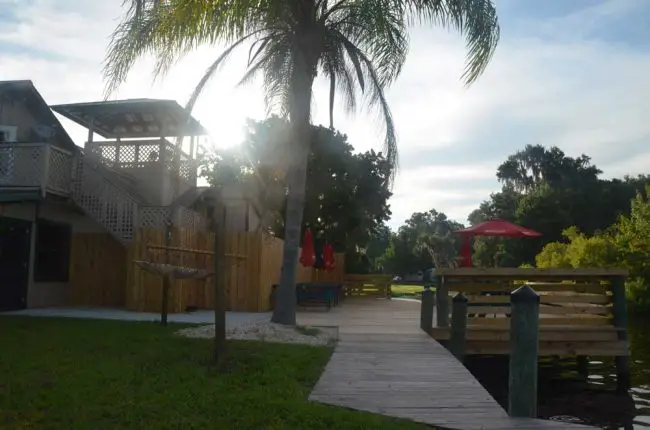
In or out of the county’s hands, Bull Creek Fish Camp has been part of Flagler County’s history since before it was so named. Sitting at the confluence of Bull Creek and Dead Lake, it was the last stop of steamboat trips down the St. Johns River and through Crescent Lake, ending at what today is the fish camp location. Hence the lake’s funereal name.
“A restaurant here is called The Bull Creek Fish Camp and each year hosts hundreds of devoted fishermen who arrive in their camp trailers towing boats,” Bill Ryan, Flagler County’s premier historian, wrote in his Journey into History, a 2018 book about Flagler County. “They follow the water temperatures across the United States for the ‘best catching locations’. In early winter, usually February to March, they arrive here for contests with large prizes.”
Flagler County government bought the fish camp’s 6 acres as part of a 29-acre, $1.81 million acquisition with dollars from the taxpayer-supported Environmentally Sensitive Lands fund, and in 2014 re-launched the fish camp’s restaurant with new owners.
But rising seas are not only eroding the sea shore and flooding properties there. The rise is affecting inland properties that sit on interconnected watersheds, as Bull Creek does: the St. Johns River rises and falls in echoes of storm surges, and with it its tributary creeks and lakes. When it last did, during Hurricanes Ian and Nicole, Dead Lake waters flooded the fish camp’s restaurant. And stayed there a month.
Last week, to the dismay of the current lease holder, County Administrator Heidi Petito informed commissioners by email that the 2,500 square foot restaurant building and the 700 square foot apartment on top of it will be torn down next month, after suffering what the county describes as irreparable damage from the flood.
“The costs necessary to fully restore the structure to its before-damage condition exceeds 50% of the structure’s valuation (excluding the valuation of the land) before the damage occurred,” Petito wrote. “The basis for this determination includes, but is not limited to, structural, mechanical, and electrical damage.”

The building’s age was considered, as well as its construction – wood frame on wooden piles – which is not eligible for repair to current building code, a county release stated. Demolition and replacement would be required. Conservative estimates for new construction of a 2,800 square foot building are upwards of $1.8 million.
That cost “is probably very conservative, as we would have to do additional boring samples because this area is built on a ‘cord road’ (layers of trees and soil) and we would likely have substantial costs for foundation work,” Petito said. “Today we have met with our tenant to make him aware of the county’s decision to red-tag the facility and proceed with demolition.”
The county does not have that kind of money right now. It just finished building the Sheriff’s Office its new operations center in Bunnell, a $21 million project, it is planning to build a new South Side public library, whose own footprint keeps getting eroded by county pressures to make it smaller and less expensive, and it is facing insistent requests from the county’s Health Department for improvements to that facility. A restaurant building in the nether regions of the county simply would not rate high on the priority list.
“The county is assessing options, but there is no funding in the current fiscal year,” a county spokesperson said Thursday.
The county’s other amenities there, including the camp ground, fabulous fishing and undisturbed flora, are not affected, though the restaurant certainly was a draw for those who chose the campground’s spectral isolation.
On the other hand, the county may choose to resurrect an old idea: planting revenue-generating cottages there, the way it has at Princess Place Preserve (not without some controversy).
The county a few years after it bought it had considered tearing down its non-performing restaurant and replacing it with lodging. The location had at one time been home to a three-story hotel.

Then came Chris Zwirn and partners Matt Crews and the late Joe Rizzo, all of whom long seeped in restaurant ownership and management. They took over the Bull Creek Fish Camp restaurant in 2014, reviving it thanks to a generous lease. The county charged $1,000 a month rent. It was due to rise $100 a month starting at year six, but it has not. The restaurant owners were also to get a 50-50 split from usage fees at the adjacent county park.
By 2018 Zwirn was the sole owner. Last fall, before the hurricanes struck, he let Petito know he was selling the business, and in September the county agreed to shift the lease to Domenech Base Inc., a Bunnell-based company established at the time by Alberto Domenech, who runs the Latino Market and Bakery at Palm Coast’s St. Joe Plaza. The rent was to stay at $1,000 a month, increasing by 3 percent a year after the first year. The county extended the lease to 2037. It had been set to expire in 2029.
Then the storms struck.
Domenech had gotten a few months’ use of the property rent-free, to prepare the transition. After the storms, he had sought to repair the property himself, at his own expense. Daytona Beach’s Zahn Engineering conducted an independent inspection for the county, and looked into possible damage reimbursements from the Florida Division of Emergency Management and the Federal Emergency Management Agency.
“It was determined that no funding would be available through DEM or FEMA, and that our current insurance policy does not cover flooding,” Petito said. “This facility is a non-conforming structure that sits in the floodplain, and is ineligible for flood insurance.”
“There are substantial deficiencies throughout the structure,” the two-page inspection report states.
The report lists deficiencies, from uneven floor slabs to deteriorated wood posts to sagging beams to numerous indications of water damage. But the inspector could not verify foundation elements or footers under the existing slab, electrical or plumbing installations.
“The improvements required are extensive and are estimated to far exceed 50% of the buildings appraised value,” the inspector, Peter A. Zahn, concluded. “This requires the building to be brought up to the current Florida Building Code: foundation, structural, doors & windows, electrical, mechanical, plumbing, handicap accessibility. This will require the [finished floor elevation] to be a minimum of 1-foot above the [base floor elevation] (approximately 4’ above current existing grade). Remediation of the existing structure will be financially unfeasible due to the above [Florida Building Code] code requirements.”
The county’s release listed some of the issues found at the building: “exterior high-water mark 3 feet above grade; could not verify “load path connection” at the slab; walls and structural wood posts were black, some soft and deteriorated from water damage; uneven flooring; sagging overhead beams; filth from both flood waters and septic backup; wiring impossible to inspect; and a host of other problems that, in short, are ‘substantial deficiencies throughout the structure.'”
The county offered to allow a food truck with a screened in pavilion at the site. Domenech declined. In a brief phone interview today, Domenech was not convinced that the building had to be torn down. He made the difference between buildings damaged at the seashore as opposed to buildings inland, where flood damage can more easily be mitigated, and said the building could have stood “a hundred years.” But it was the county’s decision. “I don’t want to create conflict,” he said.
When the county bought the camp in 2007, it consisted of a main building built in 1997 with a restaurant area on the first floor and an apartment on the second floor. It also had a 20-slip marina and a boat ramp, and the 50 full hookup camp sites. All of that remains, of course. The area is dominated by large, old-growth cypress and mature sweet gum, red maple and cabbage palm, all of which contributed to the county’s desire to buy the land. The two appraisals the county conducted came in at $1.723 million and $2.06 million, resulting in the $1.81 million purchase price.
The county had been interested in the property since the early 1990s. But “at that time a title cloud on the property thwarted the county’s purchase attempt from an owner named Kinney,” documents from the County Commission’s December 2007 meeting state. Charlie McCraney bought the property in 1994, and approached the county for a possible purchase with sensitive lands dollars.
The fish camp’s future is now uncertain, with nearby Dead Lake bearing its name like an epitaph to the property.
![]()






























David Schaefer says
This is terrible news. What a great place to watch the sunset and have a good meal.
Bill says
So, it’s OK to spend many millions to restore the beach, but for the historic Fish Camp?????? nothing? Good going Petito. Chose your enemies well.
Dennis C Rathsam says
Can you see it now folks….Dead Lake Luxury Townhomes! Water front living at its finest….Starting in the low 4ks.
JonQPublik says
Is there a farmer’s market in west Flagler? Heck, a fish and farmer’s market?
Sundays: Thrift market, kind of like car boot sales. Set up in the morning, tear down by 5pm (or whatever). No permanent storefronts.
I like the idea of food trucks, but IDK if it would be beneficial to those operators unless on days of events like above.
Gone fishing says
The County is under financial constraints they don’t have money to pour into this spot. I say sell to a company that could use the Marina and RV park.
Considering that it will cost 250,000- 500k to replace the building either way the new lease holder is out of business. He took the risk and a Florida hurricane put him out of business just like many others in the State that are out of business too nobodyhelping them but FEMA or the SBA.
Did he have insurance to help him?
Or just like everything else in the County, Palm Coast, City of Bunnell and Flagler Beach is missed managed as they allowed the guy to operate with improper insurance.
I say your out of insurance you’re out of business.
So let’s go back to the sale shall we, discount the property for the price of the building and sell the property.
The lease holder can make his bid then.
Get this liability of our books.
Bill Boots says
Keep this situation in mind, all of a sudden an ‘Insider’ will make an offer to buy from County and build new and increase amount of campsites and boat slips!
John Stove says
Unfortunately time and nature has caught up to this building and its time to pay the bill. As constructed this building cannot and should not be reconstructed due to to all of the sub-standard previous construction. If the land owner (Flagler County) wants to allow a new structure to be built on that location, it has to comply with all aspects of the current building code in order to be eligible for a building permit and eventual insurance.
As part of a parcel purchased thru the Environmentally Sensitive Land fund, the structure should be torn down and let the land revert to its natural setting.
Robert Joseph Fortier says
Yet we build homes on the shoreline. Will we allow them to rebuild on the shores of Flagler Beach?
Going to miss that place…one of the few places in West Bunnell to be proud of and offer visitors aa place to chill on the River.
Wow says
This is very sad. The county can come up with billions for fancy government buildings but will do nothing for the fishermen, boaters and kayakers who use the camp. I’ve kayaked there from Haw Creek.
I wonder what they will do with the area now?
Bear Man says
If we can get the current owner to agree to pay $1000 a month still, I think the 1.8 million to build is a no brainer. The county has showed their skill in being a landlord over the years. We are getting taken on the east side of the county by the barbecue clowns…..we might as well get taken on the west side as well to remain balance. In all seriousness, I think Heidi is making the right decision. Tear it down and make a facility that can be rented out for special events. The same should be done at the Mala Compra archaeological site. Evict the barbecue clowns and use the land for what it was intended.
Paul Bick says
One need only look to the historical records to see that the Saint John River watershed is very prone to flooding even without named storms taking a toll. Charming as it is, the fish camp cannot stand as a business model the way it is and in any case the county is not a business enterprise so we should not expect our leadership to run for-profit operations. I am sure however, that another assessment could reveal that the building is indeed restorable albeit at a cost beyond which the county is willing to pay. To be viable the restaurant would need to increase its seating capacity which raising the structure would allow for without increasing the footprint. As for the camping, that’s little more than an administrative headache that the county is relieved of but not a significant money maker. The “marina” is a joke and in it’s current state is a liability with several abandoned or unserviceable boats in residence. Reassess, raise the building, increase the seating capacity and the parking for both restaurant and trailer parking, get a proper outfitter in there with boat, kayak and canoe rentals and ditch the hobo marina. Build it and they will come or do we lose a cherished spot that locals call their own? If we accommodate the realities of nature’s cycles in our planning vs. reacting to economic expedients we can preserve and enhance the unique aspects of the old Florida here in our ever growing community. Let’s think twice shall we? Once its gone, well, its gone.
FlaglerBear says
My wife and I will miss the place. Not only did we enjoy the occasional afternoon getaway from the suburbs with a little country drive; the seafood was some of the best around. And the view was peaceful, the people nice. What a shame.